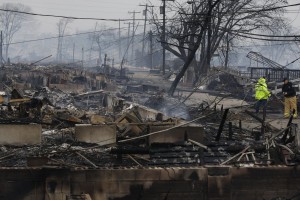Ignoring the dangers of Global Warming, can only be avoided as long as those dangers are not affecting us now in our day to day lives. We simply seem to have the pretense that our problems now with the climate cannot hurt us in the present so we can kick the can down the road to future generations to deal with when the hammer falls on them. But what if the pressures of the climate change are becoming too severe? As many experienced first-hand, Hurricane Sandy devastated a significant portion of Atlantic City, New Jersey. The damage was insurmountable and the state of New Jersey is still reeling roughly a year and a half later.
Scientists across the board are pointing out a horrificfact, that Hurricane Sandy could have signifagnctly less damaging of a superstorm. Sea levels were noted to be 1 foot higher than they have ever been, which is directly linked to global warming. Also, due to warming in the Arctic did not blow off the eastern coast into the Atlantic, but instead leveled the coast of New Jersey. A fact that is also pointed out is that these storms cannot be prevented, but due to the change in climate these storms have become terrifying superstorms that are dealing tremendous damage across the world.
Scientists have proposed 3 ways that climate change could have impacted the utter severity of Superstorm Sandy.
- Sea-levels Rising.
- Sea temperatures warming.
- Changing weather patterns.
One thing is for certain, storms in the future could be much more devastating due to the ever-changing climate, and the effects of global warming.
-Connor Mulcahy
http://www.huffingtonpost.com/2012/11/06/hurricane-damage-climate-change_n_2081960.html
http://www.huffingtonpost.com/shan-wells/hurricane-sandy-climate-change_b_2047384.html
http://www.huffingtonpost.com/2012/10/31/climate-change-hurricane-sandy-global-warming_n_2050516.html




